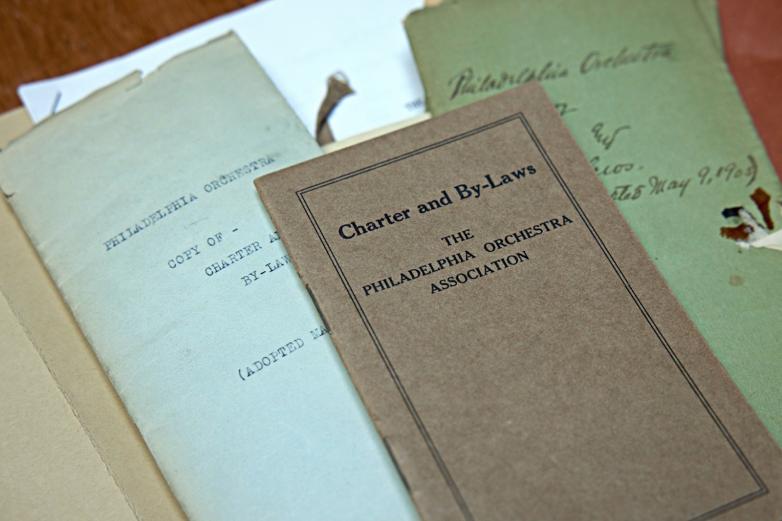Historic Partnership Acquires Philadelphia Music Archive

Early charter documents of The Philadelphia Orchestra Association.
Two iconic Philadelphia institutions are teaming up to provide public access to an extraordinary historical collection. The University of Pennsylvania Libraries has acquired the archives of The Philadelphia Orchestra and the Academy of Music in an agreement that will facilitate research and access to more than a century of Philadelphia’s rich musical history.
“These archives are an invaluable resource for scholars and a treasured part of the cultural life of the city of Philadelphia,” said Penn President Liz Magill. “Through this unique partnership, Penn is helping to preserve these materials and provide access that will spur new research in music, history, architecture, and other fields. We are honored to have the Penn Libraries serve as home to these important historical treasures.”
The materials document the early history of both institutions, starting with the time leading up to the Academy of Music’s opening in 1857 and The Philadelphia Orchestra’s founding in 1900, and trace the development of both organizations through the early twenty-first century. The Philadelphia Orchestra has owned the Academy of Music since 1957 and performed there for 101 seasons before moving to the Kimmel Center in 2001.
“The cultural history of Philadelphia is in many ways defined by stories of The Philadelphia Orchestra and the Academy of Music,” said Matías Tarnopolsky, president and CEO of The Philadelphia Orchestra and Kimmel Center, Inc. “That this rich history will now be widely available to anyone interested in learning more about music and culture in Philadelphia and beyond is entirely thanks to this flagship collaboration.”
The archives will become part of the Penn Libraries’ Kislak Center for Special Collections, Rare Books and Manuscripts, where they will be made accessible to the public after being processed and catalogued. The Kislak Center is also home to the personal papers of legendary Philadelphia Orchestra conductors Leopold Stokowski (1882-1977) and Eugene Ormandy (1899-1985) and many other collections relating to the city’s musical and artistic heritage.
“The Penn Libraries is eager to begin the work of accessioning, processing, preserving, and making this remarkable collection newly available for research and discovery,” said Constantia Constantinou, H. Carton Rogers III Vice Provost and Director of the Penn Libraries. “It is sure to inspire critical inquiry and creative expression by students and faculty at Penn, partner organizations in Philadelphia, and researchers around the world.”
At more than one thousand linear feet, this collection is prodigious in both physical size and in its research significance. With records that include everything from early stock certificates and bylaws to conductor’s files, photographs, programs, and sound recordings, the archive will enable research by musicologists, architectural and urban historians, and practicing musicians and conductors.
“The Philadelphia Orchestra played a crucial role in the complex unfolding of western art music in the 20th century: it was equally important to such disparate composers as Sergei Rachmaninoff and Edgard Varèse,” said Jeffrey Kallberg, a specialist in music of the 19th and 20th centuries and Associate Dean for Arts and Letters in the School of Arts and Sciences at the University of Pennsylvania. “Musicologists will now have the opportunity to explore in depth the inner workings of one of the world’s great musical institutions, and thereby expand on and deepen our understanding of a significant era in music history.”
The Penn Libraries has already begun the meticulous work of processing the collection and will gradually allow for access as descriptive guides, known as finding aids, are published to help researchers navigate the large collection. The process is expected to take several years to complete. As materials are made available, there will likely be an immediate demand for their use: the collections have been closed to researchers for the past fifteen years, and The Philadelphia Orchestra has fielded almost-daily requests from those hoping to access its archives.
The partnership will also allow for continued growth over time: the institutions will collaborate to archive new materials produced by The Philadelphia Orchestra and will explore digitization of especially valuable research materials in all formats.
The Academy of Music, a National Historic Landmark, is the oldest continuously operating opera house in the United States. Its archive extends back to its planning in the early 1850s and documents the opening of the building in 1857 and its functions, events, and activities thereafter. Records consist of administrative and financial documents; daily logbooks and journals of concerts and events; concert and event programs; correspondence; seating and subscription records; scrapbooks and clippings; prints, illustrations, and photographs.
The records of The Philadelphia Orchestra encompass a wide range of formats: printed and published matter, manuscript materials, photographs, original audio/visual materials, commercially released LPs and recordings, and more. There are account books and ledgers dating from 1900 that document the early finances of the Orchestra as well as early administrative, legal, and personnel records. Major categories include board minutes, concert programs, and files of conductors, musicians, and guest artists.
The Orchestra archive also contains materials from individuals and groups affiliated with the organization: images by Adrian Siegel (1898–1978) who began his Philadelphia Orchestra career as a cellist in 1922 and later became its official photographer until the mid-1970s; a complete set of the Orchestra’s original 78 rpm recordings from the collection of Donald Wetzel, audio engineer for the Philadelphia Orchestra’s radio broadcasts from 1962 to 1977; and files from The Philadelphia Orchestra Women’s and Volunteer Committees.















